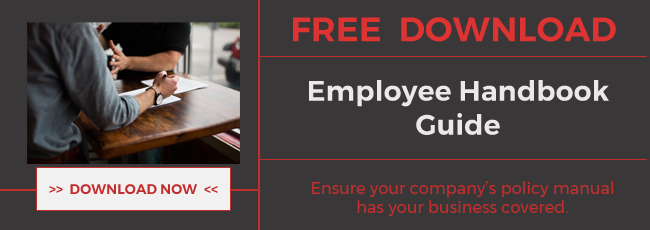Every business should have a policy for employee disciplinary procedures. This resource and tool serves both the employee and management on a number of levels. But many organizations struggle with developing and creating a quality disciplinary policy.

Discipline in the workplace is a task that no one wants to have to engage in. Employee discipline is a process that managers can employ to address poor behavior and enforce compliance with company policies. It is important to keep in mind that that the purpose is to correct behavior. not to punish or embarrass an employee.
For a number of reasons, both legal and practical, employee discipline should be confined to verbal and written warnings, letters of suspensions, or - if deemed appropriate - actual termination. Employers and managers should not alter work schedules, assign employees unpleasant work, or deny vacation requests simply to punish an errant worker.
In fact, using a positive approach can often solve a problem without having to engage in some form of employee disciplinary action. However, if unacceptable behavior continues to be a problem, or an employee behaves in ways that cannot be tolerated, management should be able to use disciplinary actions to correct the behavior.
And this should be defined by and documented with a clear company policy.

Employee Conduct and Company Culture
One of the signs of a disengaged manager is the lack of communication required to foster trust and provide consistent guidance. This issue is addressed by Rutgers University Human Resources,
Discipline should not generally come as a surprise to the employee. Occasionally employees are unaware of their supervisors' dissatisfaction until they suddenly receive a formal written reprimand or a letter of termination. Try to avoid this situation if possible and attempt to regularly communicate issues to employees rather than wait until the performance problems can no longer be tolerated or until annual performance reviews are conducted.
Another element that will prevent awkward and uncomfortable confrontations between managers and employees engaged in misconduct, is a culture and practice of regular one-on-one meetings. These could be done as often as once a week, or only monthly, but more frequently is often better.
These sessions will allow a manager or supervisor to address issues early on and to follow up with the employee, which will often preempt the need for any disciplinary steps.
The time for a disciplinary policy is before one is ever needed. When's the best time to introduce your policy? According to XpertHR,
Before beginning work, employees should know what conduct is expected at work and the employer's disciplinary policy. If there is not an established policy, employees can argue that the employer failed to provide notice of prohibited conduct and employees were not informed of the possibility of disciplinary proceedings. The policy should also reiterate the employer's position that all employment is at-will.
The employee conduct and discipline policy should be communicated to employees before beginning employment, and the employer should make sure that employees sign and acknowledge that they have received a copy of the policy and understand it.
In short, much of what makes up an organization's culture will determine both the degree of potential employee misconduct and the need to resort to disciplinary actions on the part of management.
Progressive Discipline Policy
Generally speaking, probably the best approach to employee disciplinary action is what is commonly known as a "progressive discipline" approach.
Simply put, this entails a clearly defined set of actions that can be taken in response to undesirable employee actions or behavior issues. Here is a simplified and high-level overview of this technique:
- When addressing a problem with an employee, specify the actions or behavior to be corrected and how corrective action will be undertaken. Ideally, when first addressing the issue, the employee should be given advice and guidance rather than an official reprimand. It is important to document all discussions of this nature with employees.
- If there is little or no improvement, suspending the employee without pay for a short period of time is appropriate. In a suspension letter to the employee specifically state that the employee will be subject to further suspensions without pay or termination if there continues to be insufficient improvement within a specific time period.
- After the stated period of time, if there is insufficient improvement, provide a formal letter to the employee that explains the reasons for your dissatisfaction with his or her conduct. Ultimately it may be necessary to write to the employee to indicate that he or she will be terminated if there is insufficient improvement in the conduct.
While the specifics and details of this approach will vary with most businesses, the critical point is to both document and publicize the policy within your organization. As noted previously, both managers and employees must be aware of and clear on the policy before it is ever required to put into action.
Along with making certain your policies are clearly communicated and understood, it is important to establish and reinforce a culture of expected and acceptable behavior. Each business is unique and the culture of each business is unique to that organization. Consequently, what is considered "acceptable" behavior or conduct in a skateboard shop, for example, might not sit well in a corporate law firm.
Regardless of the type of business, however, the common components are communication, role modeling, and consistency on the part of management.
HR Management Help for Your Team
A comprehensive policy manual will help your business articulate its obligations and expectations, while providing guidance to managers for labor law compliance. It pays to take time to understand the law and to prioritize the development of policies and procedures.
Another key step in maintaining HR compliance, while increasing your company's cost-effectiveness, is to consider outsourcing. A professional agency such as Accuchex can provide much-needed help with Human Resources needs and questions.
Accuchex is a full spectrum Payroll Management Services provider offering expertise in Time Management, Insurance and Retirement issues, as well. Sign up for our free "My HR Support Center" tour.




